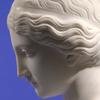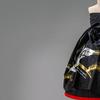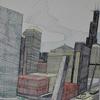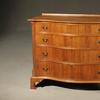“Pattern, Costume and Ornament” Explores the Meanings of Decoration in Contemporary African and African-American Art
- BIRMINGHAM, Alabama
- /
- June 15, 2010
“Pattern, Costume and Ornament” opened at the Birmingham Museum of Art on June 6 in the Bohourfoush Gallery. The works gathered in the exhibition were created by African and African-American artists and drawn from the Museum's permanent collection and from local private collections.
Ron Platt, The Hugh Kaul Curator of Modern and Contemporary Art, organized the exhibition. “These works are united by a visual presentation that emphasizes eye-catching arrangements, attention to detail and embellishment, and often both,” says Platt.
Functional objects, including a quilt and a Haitian vodou flag, mingle with contemporary painting, sculpture and photography. Each work invites the viewer to consider the diverse cultural influences on personal identity, reaching out to ancestry, tradition, and community for iconography and understanding.
Aside from the complex meanings they evoke, these works also can be valued simply for the visual pleasure they impart. Eye-catching arrangements, attention to details, and interesting use of common materials draw the viewer into the pieces.
The exhibition “Pattern, Costume and Ornament” includes the following works, as well as others:
Imminence (1976)
Founded in the 1960s by the artist, Jeff Donaldson, and a small group of other African-American artists, the AFRICOBRA movement was intended to herald a new black aesthetic that drew on African traditions, political awareness, and community engagement. This portrait of Donaldson and his own family is suffused with the symmetrical patterns and improvisatory nature of West African visual culture. In doing so, he pays homage to Africa and his ancestral lineage. The work’s title may well refer to the forthcoming birth of his second child. Imminence is a 2009 addition to the Museum’s collection, acquired with funds from the Museum's Sankofa Society: Friends of African-American and African Art.
Old Salem: A Family of Stranger, Series Two (1995)
Fred Wilson's photographs of 19th-century cloth dolls, lovingly costumed and personalized by African African-American artisans in Old Salem, North Carolina, provide a vital historical counterbalance to the overwhelmingly negative portrayals of black Americans from that time. The arrangement of photographs on a long wall in the Bohourfoush Gallery evokes a family tree.
I Looked and Looked and Failed to See What So Terrified You (2003)
These photographic self-portraits by Carrie Mae Weems show the artist costumed in a dress that directly refers to the rich Southern African-American quilt-making tradition. The photos are from The Louisiana Project, Weems’s ambitious multi-part work that explores New Orleans’s history of social and racial hierarchies and codes. Weems’s dress—patterned on a Log Cabin design—expresses her identification with the region’s rich African-American heritage. She also intends her garment, an object stitched together from numerous pieces of cloth, to signify the city’s unique racial mixture.
Sound Suit (2009)
For his body of work entitled Sound Suits, Nick Cave draws on numerous sources such as carnival and Mardi Gras, traditional West African sculpture and ceremony, performance art, feminism, craft, and modern dance. Cave creates his wearable sculptures from such materials as buttons, twigs, leaves, handmade fabrics, sequins, and hair. The artist aims for his works to seem alive, to “recall the African positing of spiritual powers in objects.” He considers his work a catalyst for change and hopes that “the people who see it will be fueled by their experience with it.” The Sound Suit in this exhibition is embellished with materials such as crochet doilies and colorful buttons.
The exhibition “Pattern, Costume and Ornament” will remain in the Bohourfoush Gallery of the Birmingham Museum of Art through Septmember 12. Find information for visiting the Museum, including directions and hours, at www.artsbma.org.
About the Birmingham Museum of Art: Founded in 1951, the Birmingham Museum of Art has one of the finest collections in the Southeast. More than 24,000 objects displayed and housed within the Museum represent a rich panorama of cultures, including Asian, European, American, African, Pre-Columbian, and Native American. Highlights include the Museum’s collection of Asian art, Vietnamese ceramics, the Kress collection of Renaissance and Baroque paintings, sculpture, and decorative arts from the late 13th century to the 1750s, and the Museum’s world-renowned collection of Wedgwood, the largest outside of England.
2000 Rev. Abraham Woods, Jr. Blvd
Birmingham, Alabama
















